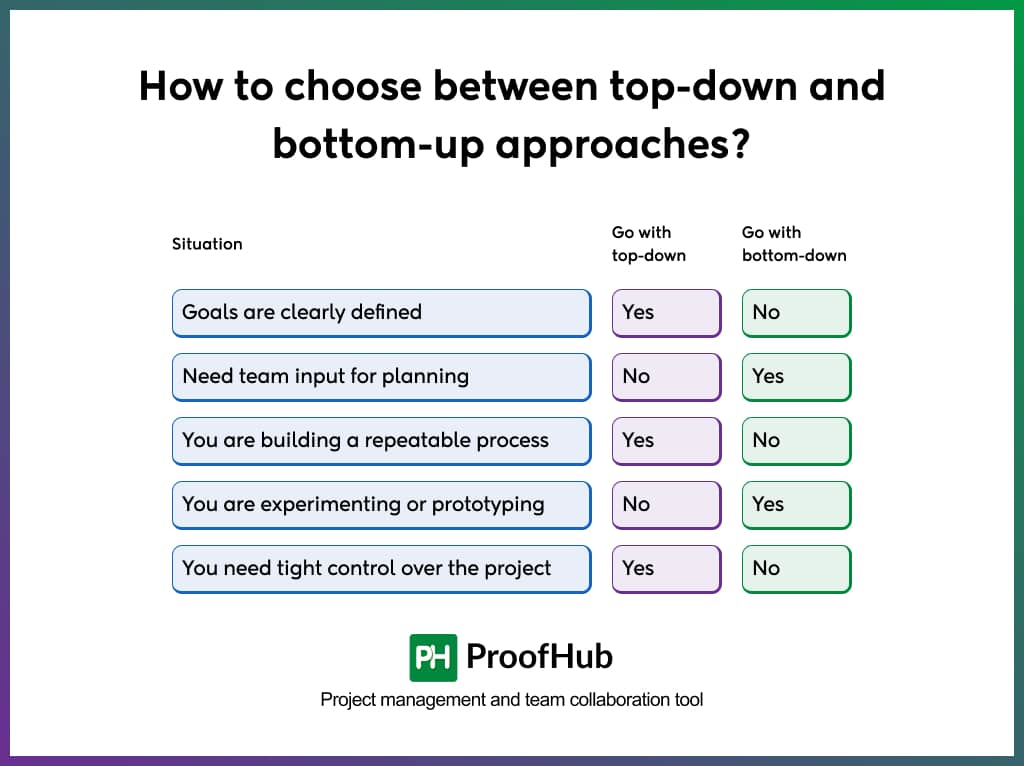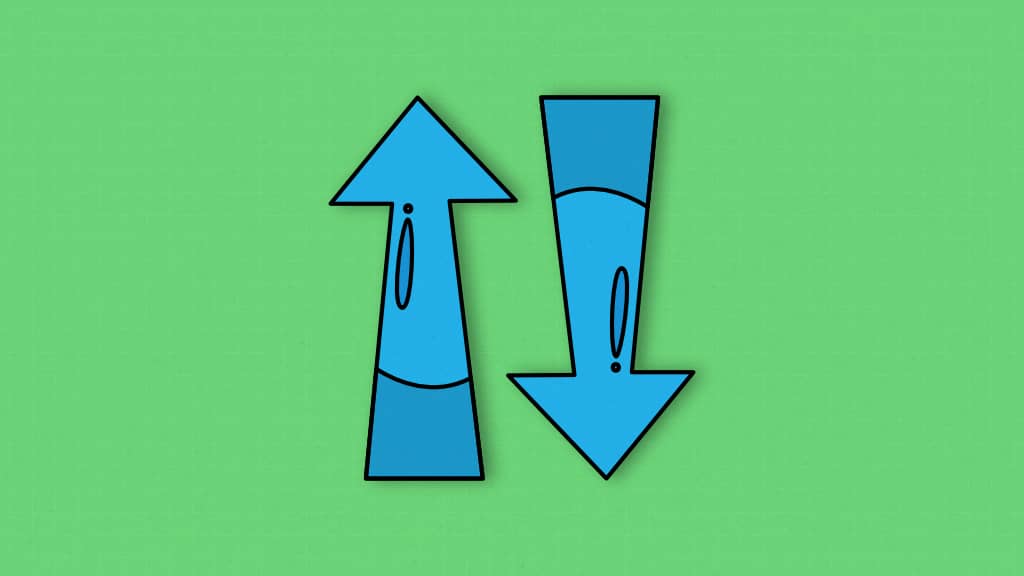Every project needs a good plan to succeed. A big part of that plan is breaking the large work into smaller steps. That’s where a work breakdown structure (WBS) helps. It enables the project manager to break down a large project into smaller, manageable tasks, allowing teams to stay organized and on track.
But before creating a WBS, you need to decide on your approach. Should you start from the top by defining the outcome first and breaking it down? Or begin from the lowest level by identifying detailed tasks first and building upward to reach the outcome?
These two methods are known as the top-down and bottom-up approaches. Each method has its strengths and challenges. One gives clarity and speed; the other offers detail and creativity. The real question is: which one suits your project’s needs best, or should you combine both?
Remember, choosing the right approach to managing your project can make the difference between on-time delivery and missed deadlines.
Whether you’re managing a small, medium, or large project, this guide will help you choose the right approach for better project outcomes. We will explore the key differences between these two approaches, examine their pros and cons, and discuss how to use both for your project.
What is the top-down approach in project management?
The top-down approach to project management is a method where the outcome or deliverable of a project is defined first. The project deliverable is then broken down into smaller, manageable tasks and subtasks to define the work required to achieve the set goals or outcomes.
In this method, project communication and leadership follow a top-to-bottom path. Stakeholders share requirements or project outcomes with the project manager. A project manager analyzes the project requirements and creates a plan for the project team to follow.
The top-down approach works best for projects with clearly defined, predictable, and fixed outcomes or if the project is similar to past projects you have worked on or that follow a standard, clear direction. Additionally, you can use the top-down approach when your project must closely follow company goals, policies, or compliance rules.
To better understand, let’s take an example of the top-down approach.
A company is launching a new e-commerce website. The project manager, along with stakeholders, first defines the main objective: to launch the website within four months with features such as product browsing, secure checkout, and user accounts. Then, they assign tasks to each team:
- UI/UX designers to create wireframes by week 2
- Developers to build core features by week 6
- QA testers to begin testing in week 8
- Marketing to prepare for the website launch campaign
Everyone will execute their task according to the defined plan and responsibilities to achieve the desired outcome.
Advantages of the top-down approach
Applying a top-down approach to your project offers several benefits. Below is a list of these benefits
- Clearly defined project outcomes
As stakeholders share project requirements, expectations, and outcomes directly with the project manager, it provides the project manager with an enhanced understanding of what needs to be done in a project. Direct communication with stakeholders helps a project manager clarify misconceptions and ensure alignment of the project plan to achieve project goals.
- Structured and logically sequenced
When goals are set from the top, they’re broken down into clear, step-by-step tasks. This creates a structured flow, so everyone knows exactly what to do, when to do it, and how their work fits into the bigger picture.
- Faster decision-making
By granting the decision-making power to the project managers and top-level executives, project decisions are made quickly and with clarity.
There is less back and forth, which helps keep the project on schedule, especially during key milestones or unexpected changes.
- Stronger communication flow
Information and communication move clearly from top to bottom. It reduces misunderstandings and keeps all team members aligned with the bigger project objectives.
- Better inefficiency tracking
You can track project inefficiencies more easily in a top-down approach because there is a clear structure and defined expectations at every level. It allows you to take quick corrective actions and keep the project on track.
Disadvantages of the top-down approach
Like any other approach, top-down also has a set of disadvantages, which you will get here.
- Inaccurate task estimations
Because planning is done primarily by stakeholders or senior leaders without input from the people who will perform the work, the project plan may overlook technical details, potential challenges, or resource constraints. This planning gap can lead to underestimating the time, effort, or complexity involved in completing tasks, resulting in unrealistic deadlines and increased risk of delays or rework.
- Delayed issue resolution
In the top-down approach, problems are usually identified by the team members doing the actual work. However, they must get approval from the managers before resolving the issues. This can slow down progress, especially when quick, on-the-spot decisions are needed.
- Reduced flexibility
Once the plan has been approved and everyone starts working on the project, it can be hard to make changes. If something unexpected happens during the project, teams may not have the freedom to adapt quickly.
- Unrealistic planning
Project leaders may create plans and set deadlines without fully understanding the actual workload or potential roadblocks. This can lead to unrealistic expectations and pressure on the team during execution.
What is the bottom-up approach in project management?
The bottom-up approach to project management starts by generating ideas and input from the bottom of the project hierarchy, where the actual work of the project is performed, to determine the best way to achieve the final deliverable. Team members define tasks and timelines based on their expertise and provide these inputs to managers for approval. After that, a project manager combines all the input and creates a work breakdown structure.
You should use the bottom-up approach when your project is new, complex, or does not have a clearly defined path. It works best when the project’s success depends on the specialized knowledge and experience of the team members.
For example, in a website project, the design team might estimate the time required to create the layout and user experience. The development team explains how they will build the backend and the estimated time required. The content team shares how long it will take to write and add the content. Each team shares its part, and then the project manager compiles everything into a single, complete plan and schedule.
Advantages of the bottom-up approach
The bottom-up approach lets team members plan the project from the beginning. Here are the key pros of the bottom-up approach:
- More accurate project planning:
When planning starts from the low level, each part of the project is defined based on actual technical understanding and hands-on experience. This leads to more precise time estimates, better identification of challenges, and realistic resource needs. This makes the plan more realistic and easier to follow.
- Improves risk identification:
Team members often spot potential risks before they become major issues. Because they deal with the project at the execution level, they can identify technical dependencies, resource gaps, or customer-related challenges early on.
- Enhances problem-solving during execution:
Since the planning process includes the team members, problem-solving becomes faster and more effective during the project. They have deep knowledge and context, so when a challenge arises, they don’t need to wait for direction. They can act quickly and confidently.
- Builds a stronger commitment to deliverables:
When team members help shape the project plan, they feel more invested in delivering the work. This increases motivation and accountability because the team isn’t just following orders. They’re delivering on something they helped create.
Disadvantages of the Bottom-Up Approach
The bottom-up approach offers several benefits, but it also comes with its own set of challenges. Understanding these drawbacks can help you decide when this method is the right fit for your project.
- Slower initial planning process:
When team members have to decide the timeline or the framework of the project, the planning process is usually slow. First, they plan, then it is approved by the manager, and then by the stakeholders. Approval is returned to the manager, then the manager to the team members, which is a slow process.
- Aligning diverse perspectives with strategic goals:
Stakeholders’ perspectives on the project may differ from those of the team members who will work on it. Team members may focus on what is practical or familiar based on their expertise, while stakeholders may have a broader vision that encompasses business goals, customer needs, or market positioning.
- Requires strong communication and coordination:
The multiple levels present in the bottom-up approach and the team members require stronger communication skills. Without collaboration skills, the planning process can become disorganized or result in duplicated efforts.
- Too much focus on individual tasks:
When teams plan their own work, they may focus solely on their own part, missing how it fits into the broader picture. This can cause the project to lose direction or miss key priorities.
Key Differences between top-down and bottom-up management
Top-down and bottom-up are two different project management approaches. The top-down approach is ideal for projects where goals are already defined, while the bottom-up approach is better suited for situations that require flexibility and creativity. Let’s look at their key differences.
| Aspect | Top-down approach | Bottom-up approach |
| Flow of information | Information flows mainly from top to bottom | Information flows primarily from bottom to top |
| Project planning | The managers or stakeholders create project goals and plans. | Team members help build a project plan based on what they know and what they do. |
| Control and leadership | The manager makes most decisions and guides the work. | Team members have more control over their tasks |
| Innovation | New ideas generally come from the managers or stakeholders following set procedures | Team members are encouraged to share new ideas during the project. |
| Task assignment | Managers assign tasks to each team member | The team helps decide who will do what based on their expertise. |
| Solving problem | Problems are reported to the manager, who decides what to do next | Teams solve most problems on their own because they are closest to the project. |
| Making changes | Changes need to be approved by the managers, which may take time. | Teams can adjust their plan quickly when they see that a change is required. |
| Decision-making speed | Faster decisions come from a centralized upper management. | Slower initially due to team discussions, but decisions may be more informed. |
| Team involvement | Team members follow instructions, but don’t help much with planning | The team is deeply involved in the planning and is often responsible for the result. |
| Best for | A project with clear goals, fixed deadlines, or tight goals is needed. | The project requires flexibility and creativity. |
How to choose between top-down and bottom-up approaches?
Choosing between the top-down approach and the bottom-up approach depends on the nature of your project, the structure of your team, and how much clarity you already have on the project.

Use the top-down approach when:
- The project has a clear direction, like managers have already defined the goal, timeline, and success metrics, a top-down approach ensures everything flows from that high-level vision.
- For repeatable or familiar projects (e.g., launching a standard product update or redesigning a website using an existing template), the process is already mapped out.
- When time is limited or you need to avoid delays from excessive collaboration, top-down allows project managers and leadership to make quick calls without needing suggestions from every team member.
Use the bottom-up approach when:
- The project is complex, new, or unclear, like building custom software or adding a tool with many unknowns.
- You need a detailed and realistic plan. Team members know what’s doable and how long tasks will take, so their input leads to a more accurate plan.
- Your project may face unexpected issues or need fresh ideas, like designing a new app. Bottom-up planning gives flexibility and encourages team collaboration to solve problems along the way.
You can also use a mix of both top-down and bottom-up approaches to get the desired results. This blended approach helps keep the project aligned with business goals while also using the valuable knowledge of the people actually doing the work.
Final thoughts: It’s not either or – It’s strategic
Both the top-down and bottom-up approaches help you break your project into manageable tasks. If you’re wondering which one is right for your project, it really depends on your goals and the nature of the work.
For example, if it’s a familiar project—something you’ve done before—a top-down approach can save time because the process is already clear. However, if it’s a new or complex project with many unknowns, a bottom-up approach may be more effective, as it incorporates your team’s input and expertise from the outset.
Each approach has its own strengths and challenges. That’s why it’s important to compare them carefully and choose based on what fits your project best. To make your execution smoother and truly leverage the power of top-down, bottom-up, or hybrid project management approaches, it’s essential to use the right tools that align with each method’s unique needs. You can use a project management and team collaboration tool like ProofHub. It helps you stay organized, connect with your team, and manage tasks efficiently, regardless of the approach you choose.
Frequently asked questions
What are the examples of top-down and bottom-up approaches in project management?
In a top-down approach, a company launched a website, and now they want to change it. Stakeholders define the project scope, deadlines, required expertise, and other key aspects. Then, they move these requirements to the manager, who then delegates tasks according to team members’ expertise.
- The back-end developer will design the architecture of the website
- The designer will design the front end, and the content will go to the writer to publish.
In a bottom-up approach, a software company aims to develop a new mobile shopping app. Instead of leadership setting the full plan from the start, the team members come together to discuss what’s needed.
- The developers suggest what’s technically possible.
- The designer shares UI ideas.
- The QA team highlights potential testing challenges.
Based on these insights, the project manager builds the plan and timeline. Leadership then reviews and approves the proposal. Each task is created based on the team’s input, making the project more realistic and efficient.
How do these approaches impact project outcomes?
The choice between top-down and bottom-up planning doesn’t just affect how you manage tasks—it directly influences key project performance indicators. You need to understand them before making any decisions.
| Situation | Top-down approach | Bottom-up approach |
| On-time delivery | Higher chances | Chances can vary because it may take longer to align initially, but improve after project clarity |
| Budget adherence | Easier to control with centralized planning | It can be more accurate if the team member can identify the real cost early |
| Team satisfaction | It may be lower if the team feels disconnected from planning | Often higher due to team involvement and ownership |
How do these approaches influence the planning and execution of projects?
In a top-down approach, planning starts with high-level goals set by management. Tasks and roles are then assigned based on this strategy. In a bottom-up approach, the planning process starts with input from team members who are closest to the work. They provide suggestions on timelines, risks, task dependencies, and the necessary resources.
Can top-down and bottom-up approaches be combined in a project?
Yes, top-down and bottom-up approaches can be combined in a project. It starts with high-level planning, top down but includes team members in the project execution planning. For example, managers and stakeholders set clear goals and key deliverables, and team members are asked to provide input on timelines, task dependencies, and resource needs based on their expertise. Encourage two-way communication throughout the project to fill the gaps.
Which approach is more suitable for Agile project management?
Agile project management is generally more aligned with the bottom-up approach. The reason is that the nature of agile project management aligns with the bottom-up approach. Both encourage collaboration, continuous feedback, and team-driven decision-making.

